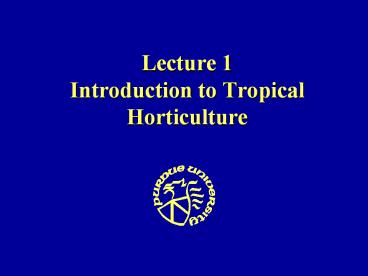Lecture 1 Introduction to Tropical Horticulture Introduction - PowerPoint PPT Presentation
1 / 35
Title:
Lecture 1 Introduction to Tropical Horticulture Introduction
Description:
Lecture 1 Introduction to Tropical Horticulture Introduction to The Tropics Hort 403 Lecture 1 Lecture 1 Introduction to Tropical Horticulture Introduction to The ... – PowerPoint PPT presentation
Number of Views:1228
Avg rating:3.0/5.0
Title: Lecture 1 Introduction to Tropical Horticulture Introduction
1
Lecture 1Introduction to Tropical Horticulture
2
Horticulture 403 TROPICAL HORTICULTURE ecourses.pu
rdue.edu
Instructor Jules Janick 330 Horticulture
Bldg 494-1329 janick_at_purdue.edu Grader Anna
Whipkey 116A Horticulture Bldg. 494-6968 awhipkey_at_
purdue.edu
3
Grades
Grades will consist of quizzes, two exams, a
final and a term paper and one extra credit
exercise. Final grade will be based on total
points. PointsQuizzes 100 540-600 A Exam
1 100 480-539 BExam 2 100 420-479 CTerm
Paper 100 360-419 DFinal 200 lt359
FTotal 600
4
Introduction to The Tropics
An introduction to the agriculture of the tropics
and subtropics emphasizing horticultural
crops. The course covers aspects of tropical
geography and ecology, as well as historical
aspects of the tropics and subtropics.
5
Course Outline I. Tropical Agriculture
Introduction to the Tropics Theory of the
Tropics Tropical Climate The Koppen
Classification of Climates Tropical
Vegetation Tropical Soils Agricultural Potential
of the Humid Tropics Agriculture in Tropical
Systems Plantation Agriculture Hacienda
System Agricultural Development in Tropical
America Tropical Forestry Themes in Tropical
Agriculture World Population
6
II. Major Tropical Crops Tropical Agr.
Research Weed Control IPM Coffee Cacao Tea Rice
Sugar Rubber Oils Oil palm Coconut Date Cassava
III. Horticultural Crops Taro
Yams Miscellaneous Starch Crops Banana Pineapple P
apaya Citrus Avocado Misc. Fruit Crops History of
Spices Spice Crops Tropical Ornamentals Overview
7
Salubrious and Balmy vs. Hot and Steamy
There are dramatically apposing attitudes towards
the tropics, both anti- and pro-tropic sentiments
8
Cruise Ships, Waving Palms vs. Poisonous Snakes
Crocs
9
Resorts Retirement Havens vs. Slums Shacks
10
Birth of Civilization vs. Uncivilized
11
Green and Bountiful vs. Starvation Malnutrition
12
Rich in Flora vs. Monotonously Green
13
Reality Check
It turns out that all of the above views are
true. This course will attempt to present a
balanced picture of the tropics. It is true,
however, that the tropical world tends to be
underdeveloped. This course will try to develop
answers to the following questions
14
Reality Check
It turns out that all of the above views are
true. This course will attempt to present a
balanced picture of the tropics. It is true,
however, that the tropical world tends to be
underdeveloped. This course will try to develop
answers to the following questionsWhy are the
tropics poor?Why is hunger endemic in the
tropics?What is the agricultural potential for
the tropics?What is the horticultural potential
of the tropics?
15
The Tropics
Narrowly defined the tropics are those areas on
the earth's surface between the Tropic of Cancer
(23.5N) and the Tropic of Capricorn
(23.5S). The tropics represent36 of the
earth's surface20 of the land surface43 of
ocean surface
16
The Tropics
Narrowly defined the tropics are those areas on
the earth's surface between the Tropic of Cancer
(23.5N) and the Tropic of Capricorn
(23.5S). The tropics represent36 of the
earth's surface20 of the land surface43 of
ocean surface The tropics are winterless climates
where the temperature differences between night
and day are small but exceed by several times the
difference between the warmest and coolest
months. Night is the winter of the tropics!
17
(No Transcript)
18
Tropical Climates
- Warm temperatures (winterless climates lack of
frost) - Abundant rainfallDistributed either equally
throughout the year (tropical rain
forest)Extremely high in one period
(monsoon)Divided into a wet and dry seasons
(tropical savanna) - Daylength is close to 12 hours throughout the
year (continual short days) - These conditions have a tremendous effect on the
type of natural vegetation and influence the type
of horticulture.
19
Characteristics of Tropical Plants
Short day plants Colorful flowers attracting
insects Perennial (some grown as annuals in
temperate climates) Frost sensitive, some cold
sensitive Enormous plant diversity
20
Agricultural Problems of the Tropics
No break in the growing cyclepests and diseases
more intense Leached soils common Excessive rain
in Tropical Rainy and Monsoon climate Dry season
in Savanna climates requires irrigation Short
days and cloud cover restrict light High night
temperatures increase respiration
21
Tropical and Subtropical Crops
Tropical agriculture involves important
well-known crops. Major crops covered in this
course will include
Beverage CropsFruits and NutsStarchy Root
CropsIndustrial CropsGrasses (rice
sugar)SpicesOrnamentals
22
Beverage Crops
Cacao
Tea
Coffee
23
Fruits and Nuts
Avocado
Citrus
Banana Plantain
Date
Papaya
Pineapple
24
Starchy Vegetables
Cassava
Sweetpotato
Taro
Yam
25
Industrial Crops
Rubber tree
Coconut
26
Grasses
Rice
Sugarcane
27
Spices
Nutmeg
Cinnamon
Ginger
Clove
Pepper
Vanilla
28
Ornamentals
Orchids
Plumeria
Poinsettia
Bougenvillia
Philodendron
Streletzia
29
The Tropical World
The tropics are the region of the earth's surface
lying between the Tropic of Cancer (23.5N of the
equator) and the Tropic of Capricorn (23.5S of
the equator). The following countries are found
in the tropics.
30
Africa
31
Africa
32
(No Transcript)
33
(No Transcript)
34
(No Transcript)
35
(No Transcript)






























